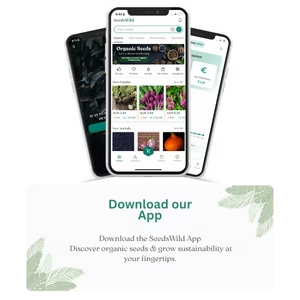Few blooms say “wild countryside” like the common poppy (Papaver rhoeas). A single glance pulls in bees, butterflies, and a wave of nostalgia. Ready to splash your beds in blazing red? Follow Seedswild’s step-by-step guide—seed to summer petal storm.
1. Quick ID Card
| Detail | Fast Facts |
|---|---|
| Family | Papaveraceae |
| Life Cycle | Hardy annual |
| Bloom Window | May – July (climate-dependent) |
| Height | 20 – 80 cm |
| Soil | Light, lean, well-drained |
| Exposure | Full sun |
🧠 Seedswild Sow_stage — Your app pings the perfect sowing window for your location (soil ≥ 10 °C and nicely drained).
2. Sowing: When & How
📅 Calendar
- Mild autumn (Sept–Oct) – mimic nature; winter chills stratify the seed → earlier spring blooms.
- Early spring (Mar–Apr) – best in cooler regions; flowers arrive a bit later (June).
✅ Steps
- Prep the patch: Hand-weed, lightly rake; skip fertilizer—poppies love poor soil.
- Broadcast sow: Tiny seeds! Mix with dry sand for even spread (~1 g per 2 m²).
- Firm, don’t bury: Press with a plank or light roller—light triggers germination.
- Mist gently: Keep the seed bed just moist until sprouting (7–14 days).
🚨 Seed Alert — If winds > 50 km/h are forecast, mulch lightly or erect a windbreak for the first few days.
3. Growing & Care: Almost Effortless
| Task | Timing | Notes |
|---|---|---|
| Thinning | 4-leaf stage | Keep 1 plant every 15 cm for dense, airy blooms |
| Watering | Rare | Only during long droughts (< 20 mm rain / 3 wks) |
| Feeding | Never | Too much nitrogen = floppy stems, dull petals |
| Diseases | Uncommon | Downy/powdery mildew in heavy soil—boost airflow |
4. Seedswild Pro Tips ✂️
- Staggered sowings: Toss a pinch each month Mar–May → rolling colour waves into Sept.
- Companions: Pair with chamomile, nigella, or flax for a self-seeding meadow mix.
- Self-sowers: Leave some capsules and shake them in late August → free show next year!
5. Why Your Plot (and the Planet) Loves Poppies
- 🌼 Biodiversity boost – early nectar magnet for wild pollinators.
- 🌱 Soil indicator – thrives where chemical fertilizer load is low.
- 💸 Budget beauty – one seed pack = square metres of colour.
- 💧 Zero-maintenance – ideal for dry banks or veggie-plot borders.
6. Harvesting Blooms & Saving Seed
- Cut flowers: Pick in the morning as buds just crack; lasts 2–3 days in cold water.
- Seed saving: Capsules turn brown and open like crowns—shake into a paper bag.
7. Quick-Fire Checklist
| ✅ Do | ❌ Don’t |
|---|---|
| Broadcast on bare soil | Bury deep (won’t germinate) |
| Firm, then mist | Flood—forms a crust |
| Thin to 15 cm | Foliage beats flowers |
| Let some seed ripen | Deadhead everything—no self-sowing |
8. Health Benefits of Poppy 🌿
Poppy flowers (Papaver rhoeas) have been valued for centuries for their calming and respiratory health-supporting properties. Rich in antioxidants and flavonoids, they are used in herbal teas to ease coughs, promote better sleep, and reduce inflammation. Poppy seeds are a rich source of calcium, magnesium, and omega-3s—great for bone strength and heart health. As always, consult a healthcare provider before using herbal remedies.
💡 Conclusion
The poppy transforms bare soil into a canvas of bold red with almost no effort. With Seedswild’s tools like Sow_stage and Seed Alerts, sowing becomes instinctive. From biodiversity to beauty, this iconic flower delivers. Ready to let the red speak? 🌺

